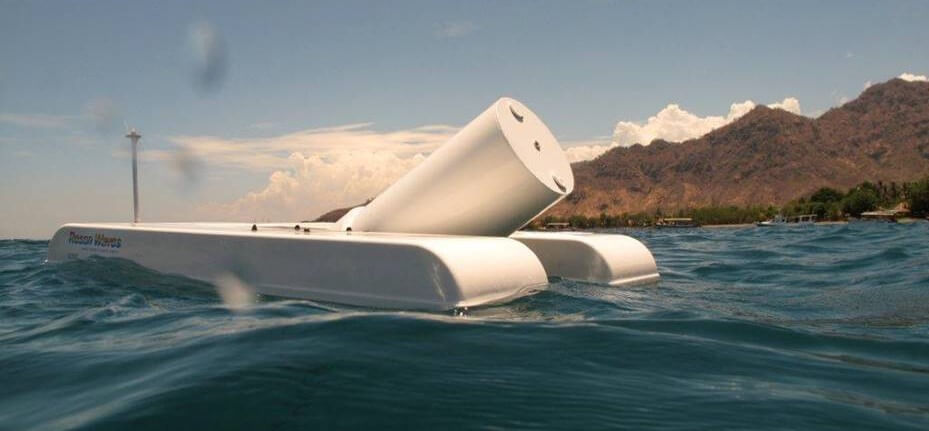Resen Waves - A 10 Year Technical History
2010


The Lever Operated Pivoting Float (LOPF) consisted of a flat rectangular float with a rotating shaft in the middle - this could drive a generator, a clock spring, and a long arm, which had a counterweight at one end and a pre-tensioned mooring line at the other end.
When the waves pushed the buoy sideways or lifted it up and down the spring-loaded arm moved forward and backwards driving a generator and producing electricity.
During storms when there are big waves the float is partly or fully pulled under water and automatically pivots into a vertical position. This automatic action limits the forces on the mooring line to the buoyancy of the buoy. The LOPF approach was the simple way to limit the forces on the buoy and protect it from being overloaded or even damaged during storms.
2012 - 2015

Our next step was to redesign the original LOPF buoy to convert it into a waterproof product which could be tested in a wave tank and later in the sea.
The arm was redesigned into a waterproof cylinder which contained the spring, gear and generator. The power was transmitted through the mooring line to the seabed.
In addition, the float was redesigned into a more streamlined U-shape leading to a much more industrial product. This version was tank tested and later sold to some early customers around the World. These included Petronas in Malaysia, PERHB in Arcachon in France and for Coral Reef Restoration in Bali - even though at this stage it was only designed for tank testing!
This image shows the buoy in the Bay of Biscay in 20m of water depth just outside Arcachon in France.
The buoy went through four (4) months testing in the sea which included three (3) summer storms with waves up to 4m height. Later it endured four (4) winter storms with waves up to 11m. Through this exposure excellent survivability was proven.
Installation in Bali 2014: Coral reef restoration project - growing corals suffering from climate change.
The buoy worked well but two issues were highlighted:
Firstly when the pre-tensioned arm swung forwards and backwards to drive the generator with the wave action, the torque on the arm changed during the wave cycle. When the arm was horizontal (0 deg) the projected arm was longest and gave 100% torque at a fixed pre-tensioning. When the arm was at +/-45 deg the torque was 70% and gradually dropped off to 0% when the arm was vertical +/-90 deg. This meant only +/-45 deg rotation the buoy could produce power, which limited the power output because the vertical displacement was limited.
Secondly the buoy also needed a function to correct pre-tensioning in tidal variation, which required an automatic pre-tensioning system on the seabed to optimize the power production /-45between +/-45 deg, which added significant costs to the system. Solving these issues was the focus of our R&D for the next generation buoy…


2017 Onwards
In 2017 the short comings were solved in the next generation of what is now the Smart Power Buoy by:
Replacing the arm with a drum, the “effective arm length” is constant and thus the torque is constant at all rotational angles plus the vertical displacement in the waves is not limited.
By putting the pre tensioning mechanism inside the drum it is also safe and drive inside the drum.
And not the least, by being able to monitor the torque on the drum the pre-tensioning can be adjusted automatically for maximum power even in tidal variation.
These developments led to the launch of a buoy which provided not only more power production but also more stability. Since 2017 we have improved the production of the buoy, carried out intensive testing plus closely collaborated with Professor Peter Frigaard from Aalborg University (AAU) and Professor Harry Bingham from the Danish Technology University (DTU) on the development of a general numerical model for the Smart Power Buoy, which enables us to optimize power production in any scale size and wave condition - truly a world first!




